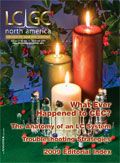Holidays 2009: A Time for Optimism
LCGC North America
For many in the world of chromatography and separation science in general, it has been a long 12 months to say the least. With an economic recession gripping the nation and causing secondary effects such as the well-documented "Great Acetonitrile Shortage of 2009," it is easy to see why many readers will not be sorry to see the end of 2009, and why they will be all too happy to welcome in 2010.
For many in the world of chromatography and separation science in general, it has been a long 12 months to say the least. With an economic recession gripping the nation and causing secondary effects such as the well-documented "Great Acetonitrile Shortage of 2009," it is easy to see why many readers will not be sorry to see the end of 2009, and why they will be all too happy to welcome in 2010.

David Walsh
However, the holidays are a time for looking forward with hope and optimism and in this regard, there is much to look forward to, as the market is full of positive indicators for the future. First and foremost, overall demand for instrumentation in the field of separation science is predicted to grow by more than 5% by 2012, while total revenue in the market is predicted to grow by 6% in the same time period, with several market segments seeing high double-digit growth (Strategic Directions International Global Assessment Report, 10th Ed.). Combine these forecasts with some of the more recent developments in the market caused by the acetonitrile shortage, such as the push toward solvent-free instrumentation, smaller-particle-size columns, and more, and the opportunities for growth are plentiful as we move into the New Year.
Finally, on behalf of all of us at LCGC, I would like to take this opportunity to wish all of our readers and their families Happy Holidays and a Happy New Year. This time of year always helps put the focus on the things in life that are most important, and I think we can all agree that economic and market conditions, while vitally important in their place, really do pale in comparison to the joy of celebrating the holidays with family and friends.

Enjoy the holidays.
David Walsh
Editor-in-Chief
A Novel LC–QTOF-MS DIA Method for Pesticide Quantification and Screening in Agricultural Waters
May 8th 2025Scientists from the University of Santiago de Compostela developed a liquid chromatography quadrupole time-of-flight mass spectrometry (LC–QTOF-MS) operated in data-independent acquisition (DIA) mode for pesticide quantification in agriculturally impacted waters.
Investigating 3D-Printable Stationary Phases in Liquid Chromatography
May 7th 20253D printing technology has potential in chromatography, but a major challenge is developing materials with both high porosity and robust mechanical properties. Recently, scientists compared the separation performances of eight different 3D printable stationary phases.

.png&w=3840&q=75)

.png&w=3840&q=75)



.png&w=3840&q=75)



.png&w=3840&q=75)










